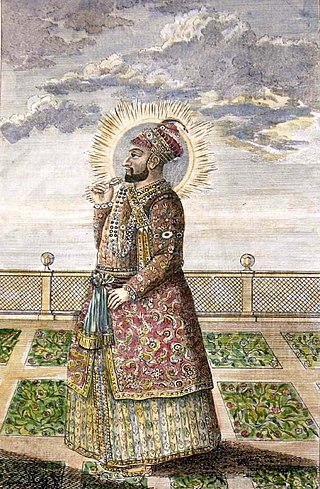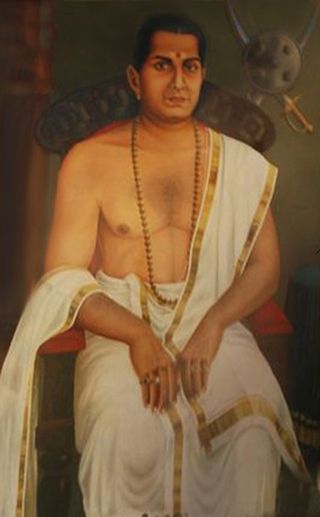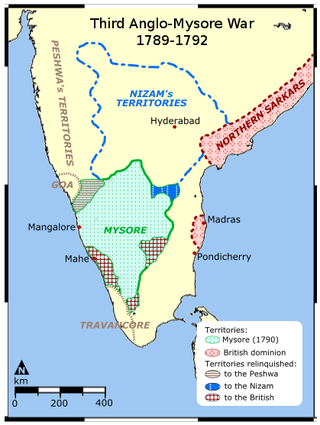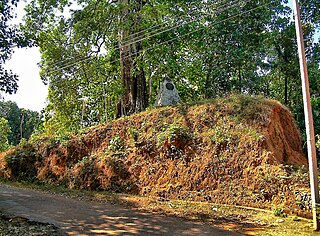
Tipu Sultan, commonly referred to as Sher-e-Mysore or "Tiger of Mysore", was an Indian ruler of the Kingdom of Mysore based in South India. He was a pioneer of rocket artillery. He expanded the iron-cased Mysorean rockets and commissioned the military manual Fathul Mujahidin. He deployed the rockets against advances of British forces and their allies during the Anglo-Mysore Wars, including the Battle of Pollilur and Siege of Srirangapatna.

Hyder Ali was the Sultan and de facto ruler of the Kingdom of Mysore in southern India. Born as Hyder Ali, he distinguished himself as a soldier, eventually drawing the attention of Mysore's rulers. Rising to the post of Dalavayi (commander-in-chief) to Krishnaraja Wodeyar II, he came to dominate the titular monarch and the Mysore government. He became the de facto ruler of Mysore as Sarvadhikari by 1761. During intermittent conflicts against the East India Company during the First and Second Anglo–Mysore Wars, Hyder Ali was the military leader.

Kerala Varma Pazhassi Raja, also known as Cotiote Rajah and Pychy Rajah, was the de facto head of the Kottayam Kingdom in the Malabar region of Kerala between 1774 and 1805. His struggles with the British East India Company is known as the Cotiote War. Pazhassi's rebellion against the British is often touted as one of the earliest acts of freedom fight in India. He earned the epithet "Kerala Simham" on account of his martial exploits.

The Second Anglo-Mysore War was a conflict between the Kingdom of Mysore and the British East India Company from 1780 to 1784. At the time, Mysore was a key French ally in India, and the conflict between Britain against the French and Dutch in the American Revolutionary War influenced Anglo-Mysorean hostilities in India. The great majority of soldiers on the company side were raised, trained, paid and commanded by the company, not the British government. However, the company's operations were also bolstered by Crown troops sent from Great Britain, and by troops from Hanover, which was also ruled by Great Britain's King George III.

The First Anglo-Mysore War (1767–1769) was a conflict in India between the Sultanate of Mysore and the East India Company. The war was instigated in part by the machinations of Asaf Jah II, the Nizam of Hyderabad, who sought to divert the company's resources from attempts to gain control over the Northern Circars.

The Anglo-Mysore Wars were a series of four wars fought during the last three decades of the 18th century between the Sultanate of Mysore on the one hand, and the British East India Company, Maratha Empire, Kingdom of Travancore, and the Kingdom of Hyderabad on the other. Hyder Ali and his succeeding son Tipu fought the wars on four fronts: with the British attacking from the west, south and east and the Nizam's forces attacking from the north. The fourth war resulted in the overthrow of the house of Hyder Ali and Tipu, and the dismantlement of Mysore to the benefit of the East India Company, which took control of much of the Indian subcontinent.

The Third Anglo-Mysore War (1790–1792) was a conflict in South India between the Kingdom of Mysore and the British East India Company, the Kingdom of Travancore, the Maratha Confederacy, and the Nizam of Hyderabad. It was the third of four Anglo-Mysore Wars.

Nedumkotta or Travancore lines was a wall built as a protection against consistent invasions from Mysore during the rule of Tipu Sultan. It was built by the Dharma Raja Karthika Thirunal, King of Travancore, with the request, support and permission of the Kingdom of Kochi. It was constructed by Rama Varma under the supervision of his commander Eustachius De Lannoy. The work was started in 1762 it was completed only by 1775. The lines consist of a ditch about sixteen feet broad and twenty feet deep with a thick bamboo hedge in it, a slight parapet and good rampart and bastions on rising grounds almost flanking each other from one extreme of the lines to the other. The construction of Nedumkotta or the Travancore Lines is considered to be a unique and unparallel episode in Indian History by historians.

Muhammad Ali Khan Wallajah, or Muhammed Ali, Wallajah, was the Nawab of the Carnatic from 1749 until his death in 1795. He declared himself Nawab in 1749. This position was disputed between Wallajah and Chanda Sahib. In 1752, after several clashes, Chanda Sahib's forces and his French allies were expelled from Arcot, officially declaring Wallajah as Nawab on 26 August 1765. His reign was recognised by Mughal emperor Shah Alam II.

The 103rd Regiment of Foot (Royal Bombay Fusiliers) was a regiment raised in 1662. It transferred to the command of the Honourable East India Company in 1668 and to the command of the British Army in 1862. Under the Childers Reforms it amalgamated with the 102nd Regiment of Foot (Royal Madras Fusiliers) to form the Royal Dublin Fusiliers in 1881.

Lieutenant-Colonel John Campbell, of Stonefield (1753–1784) was a Scottish soldier known for his defence of Mangalore.
Thengana is a town in the Kottayam district Kerala state in India and is 5 Kilometers away from Changanassery .It is famous for lord Ashik thengana who was prime member in tipu sultan battalion.
The Treaty of Mangalore was signed between Tipu Sultan and the British East India Company on 11 March 1784. It was signed in Mangalore and brought an end to the Second Anglo-Mysore War.
The Captivity of Mangalorean Catholics at Seringapatam (1784–1799) was a 15-year-long imprisonment of Mangalorean Catholics and other Christians at Seringapatam, in the Carnataca region of India by Tippu Sultan; who was the de facto ruler of the Kingdom of Mysore following its usurpation. Estimates of the number of captives range from 30,000 to 80,000, but the generally accepted figure is 60,000, as stated by Tippu himself in the Sultan-ul-Tawarikh. The captivity was the most disconsolate period in the community's history.

The Battle of Nedumkotta took place between December 1789 and May 1790, and was a reason for the opening of hostilities in the Third Anglo-Mysore War. This battle was fought between Tipu Sultan of the Kingdom of Mysore and Dharma Raja, Maharaja of Travancore. Mysore army attacked the fortified line in Thrissur district at the Travancore border known as the Nedumkotta. The Mysore army was successfully repulsed by the Travancore army under the leadership of Raja Kesavadas, Dewan of Travancore.
The Battle of Tirurangadi was a series of engagements that took place between 7 and 12 December 1790 at Tirurangadi near the port of Calicut on the Malabar Coast of India, during the Third Anglo-Mysore War.

The Mysorean invasion of Malabar (1766–1792) was the military invasion of the Malabar region of Kerala, including the territories of the Zamorin of Calicut, by the then-de facto ruler of the Kingdom of Mysore, Hyder Ali. After the invasion, the Kingdom of Cochin to the south of Malabar became a tributary state of Mysore.
James Hartley (1745–1799) was a British officer in the service of the East India Company. His employment was mainly in the company's wars against the Maratha Empire, and against Tipu Sultan of the Kingdom of Mysore.
Lieutenant-General John Le Couteur (1760–1835), a Jersey native, was a British military officer and colonial official. He was the father of the eponymous John Le Couteur (1794–1875).
General Richard Matthews was a soldier who fought with the Army of the East India Company. He fought in the Second Anglo-Mysore War (1780-84).













